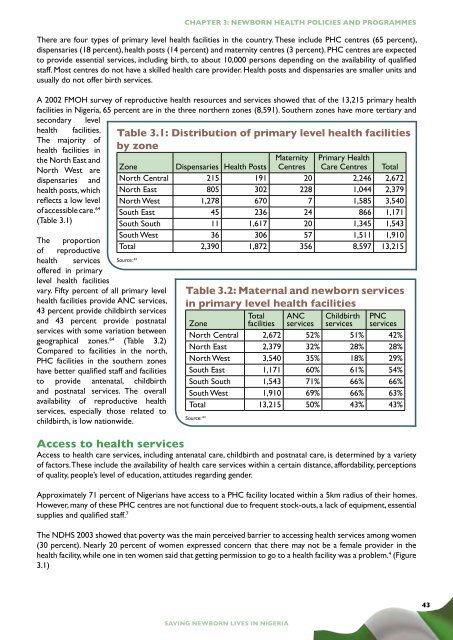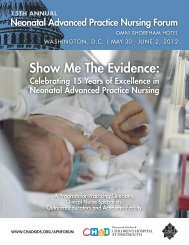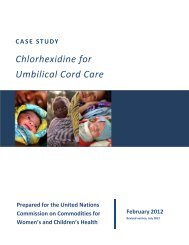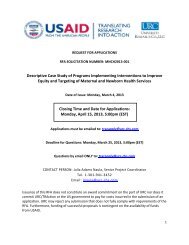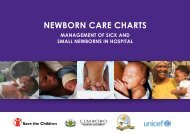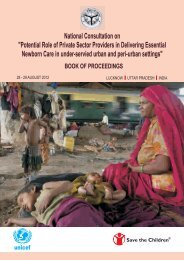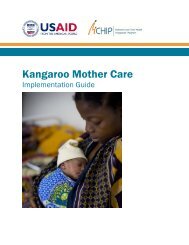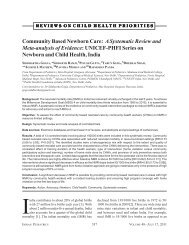situation action plan - nigeria.pdf - Healthy Newborn Network
situation action plan - nigeria.pdf - Healthy Newborn Network
situation action plan - nigeria.pdf - Healthy Newborn Network
- No tags were found...
Create successful ePaper yourself
Turn your PDF publications into a flip-book with our unique Google optimized e-Paper software.
There are four types of primary level health facilities in the country. These include PHC centres (65 percent),dispensaries (18 percent), health posts (14 percent) and maternity centres (3 percent). PHC centres are expectedto provide essential services, including birth, to about 10,000 persons depending on the availability of qualifiedstaff. Most centres do not have a skilled health care provider. Health posts and dispensaries are smaller units andusually do not offer birth services.A 2002 FMOH survey of reproductive health resources and services showed that of the 13,215 primary healthfacilities in Nigeria, 65 percent are in the three northern zones (8,591). Southern zones have more tertiary andsecondary levelhealth facilities.Table 3.1: Distribution of primary level health facilitiesThe majority ofhealth facilities inby zonethe North East andMaternity Primary HealthNorth West areZone Dispensaries Health Posts Centres Care Centres Totaldispensaries and North Central 215 191 20 2,246 2,672health posts, whichreflects a low levelNorth EastNorth West8051,27830267022871,0441,5852,3793,540of accessible care. 64South East 45 236 24 866 1,171(Table 3.1)South South 11 1,617 20 1,345 1,543South West 36 306 57 1,511 1,910The proportionof reproductiveTotal 2,390 1,872 356 8,597 13,215health services Source: 64offered in primarylevel health facilitiesvary. Fifty percent of all primary levelhealth facilities provide ANC services,43 percent provide childbirth servicesand 43 percent provide postnatalservices with some variation betweengeographical zones. 64 (Table 3.2)Compared to facilities in the north,PHC facilities in the southern zoneshave better qualified staff and facilitiesto provide antenatal, childbirthand postnatal services. The overallavailability of reproductive healthservices, especially those related tochildbirth, is low nationwide.CHAPTER 3: NEWBORN HEALTH POLICIES AND PROGRAMMESTable 3.2: Maternal and newborn servicesin primary level health facilitiesZoneTotalfacilitiesANCservicesChildbirthservicesPNCservicesNorth Central 2,672 52% 51% 42%North East 2,379 32% 28% 28%North West 3,540 35% 18% 29%South East 1,171 60% 61% 54%South South 1,543 71% 66% 66%South West 1,910 69% 66% 63%Total 13,215 50% 43% 43%Source: 64Access to health servicesAccess to health care services, including antenatal care, childbirth and postnatal care, is determined by a varietyof factors. These include the availability of health care services within a certain distance, affordability, perceptionsof quality, people’s level of education, attitudes regarding gender.Approximately 71 percent of Nigerians have access to a PHC facility located within a 5km radius of their homes.However, many of these PHC centres are not functional due to frequent stock-outs, a lack of equipment, essentialsupplies and qualified staff. 7The NDHS 2003 showed that poverty was the main perceived barrier to accessing health services among women(30 percent). Nearly 20 percent of women expressed concern that there may not be a female provider in thehealth facility, while one in ten women said that getting permission to go to a health facility was a problem. 4 (Figure3.1)43SAVING NEWBORN LIVES IN NIGERIA


